Themed collection Interaction of nano-objects with lipid membranes

Counterion release in membrane–biopolymer interactions
This review focuses on the release of counterions as an important entropic force that drives the association between lipid membranes and charged biopolymers such as proteins and DNA.
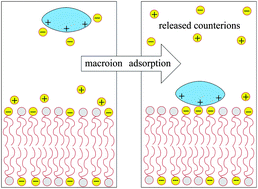
Soft Matter, 2013,9, 9268-9284
https://doi.org/10.1039/C3SM51419F
Beyond the lipid -bilayer: interaction of polymers and nanoparticles with membranes
The present review assembles investigations on lipid–polymer–nanoparticle interaction providing a more thorough understanding of these complex interactions and their effects on membrane properties, aiming at a deeper understanding of these hybrid-vesicular systems.
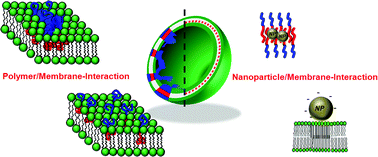
Soft Matter, 2012,8, 4849-4864
https://doi.org/10.1039/C2SM06999G
Dynamic studies of the interaction of a pH responsive, amphiphilic polymer with a DOPC lipid membrane
Experimental studies and coarse grained simulations demonstrate an amphiphilic polymer when penetrating deeper into the membrane due to increasing hydrophobicity can suppress permeability.
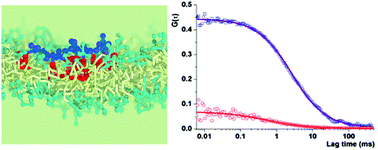
Soft Matter, 2017,13, 3690-3700
https://doi.org/10.1039/C6SM02645A
Local and transient permeation events are associated with local melting of giant liposomes
Locally induced lipid phase transitions reveal how protein-free lipid membranes exhibit transient and localized permeation.
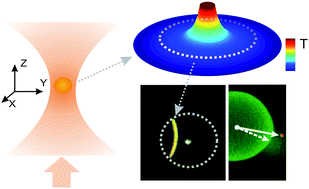
Soft Matter, 2014,10, 4268-4274
https://doi.org/10.1039/C4SM00410H
Lipid oxidation induces structural changes in biomimetic membranes
Light induced peroxidation of an unsaturated phospholipid membrane leads to membrane surface area increase, revealed by micropipette aspiration.
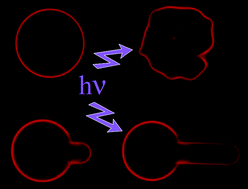
Soft Matter, 2014,10, 4241-4247
https://doi.org/10.1039/C3SM52740A
Cholesterol affects C60 translocation across lipid bilayers
The permeability of C60 decreases with increasing cholesterol concentration.
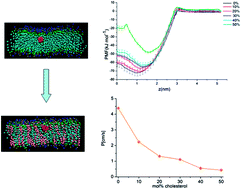
Soft Matter, 2014,10, 2160-2168
https://doi.org/10.1039/C3SM52211C
Nanomechanical response of bacterial cells to cationic antimicrobial peptides
Our study introduces an AFM-based creep deformation technique to evaluate changes in the time-dependent mechanical properties of Pseudomonas aeruginosa PAO1 bacterial cells upon exposure to two different but structurally related antimicrobial peptides.
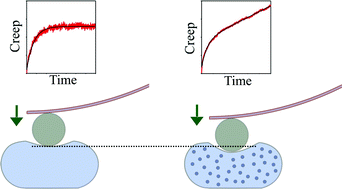
Soft Matter, 2014,10, 1806-1815
https://doi.org/10.1039/C3SM52801D
Pairing of cholesterol with oxidized phospholipid species in lipid bilayers
Cholesterol and oxidized lipid species co-localize in phospholipid bilayers owing to their complementary shape factors. The combined shape factor for a cholesterol-oxidized lipid product is ∼1.
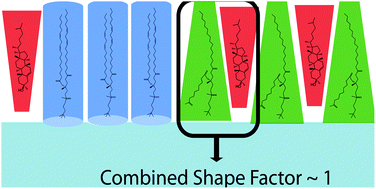
Soft Matter, 2014,10, 639-647
https://doi.org/10.1039/C3SM52310A
Internalization pathways of nanoparticles and their interaction with a vesicle
We simulated internalization pathways of nanoparticles and their interaction with vesicles, and discussed their potential implications for nanoparticle–cell interactions.
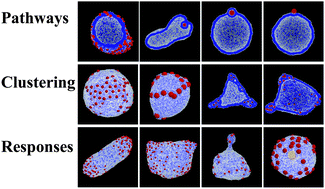
Soft Matter, 2013,9, 7592-7600
https://doi.org/10.1039/C3SM50931A
Wrapping of ellipsoidal nano-particles by fluid membranes
The wrapping of nano-particles by membranes is an important step in their uptake by biological cells. We investigate the wrapping of ellipsoidal nano-particles by numerical minimization of bending, surface tension, and adhesion energies, and predict an extended parameter regime where partially wrapped nano-particles are stable.

Soft Matter, 2013,9, 5473-5482
https://doi.org/10.1039/C3SM50351H
Deformation and poration of lipid bilayer membranes by cationic nanoparticles
Cationic nanoparticles bind strongly to lipid bilayer membranes of giant unilamellar vesicles (GUVs). This binding process is accompanied by membrane deformation, as the membrane is pulled into protrusions by the nanoparticles. This increases the tension of the membrane, forming transient pores with diameters on the order of 20 nm.
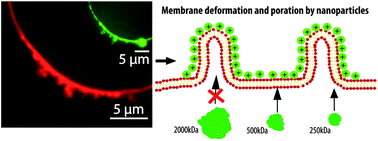
Soft Matter, 2013,9, 4969-4976
https://doi.org/10.1039/C3SM27578G
Translocation of polyarginines and conjugated nanoparticles across asymmetric membranes
Computer simulations show that the polyarginines and their conjugated particles can be translocated across asymmetric membranes by pore-mediated processes.
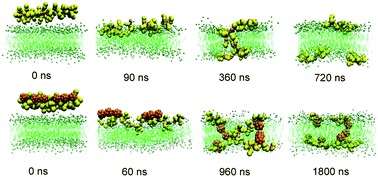
Soft Matter, 2013,9, 1281-1286
https://doi.org/10.1039/C2SM26519B
Homo-polymers with balanced hydrophobicity translocate through lipid bilayers and enhance local solvent permeability
Using Monte Carlo simulations we show that homo-polymers translocate through lipid bilayers and increase membrane permeability for solvent locally, when polymer hydrophobicity is close to the adsorption threshold.

Soft Matter, 2012,8, 11714-11722
https://doi.org/10.1039/C2SM26008E
Physical and chemical modifications of lipid structures to inhibit permeation of free radicals in a supported lipid membrane model
In order to maximize resistance to radical induced oxidation in lipid encapsulation systems (e.g., emulsions, liposomes, micelles and lipid coatings) the ideal strategy is to localize chemical protectants at the water–lipid interface.

Soft Matter, 2012,8, 11144-11151
https://doi.org/10.1039/C2SM26474A
Effects of spherical fullerene nanoparticles on a dipalmitoyl phosphatidylcholine lipid monolayer: a coarse grain molecular dynamics approach
Coarse grain molecular dynamics simulations are used to investigate the effect of spherical fullerene molecules on a dipalmitoylphosphatidylcholine lipid monolayer, which is a model pulmonary surfactant monolayer.
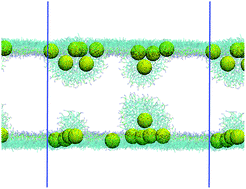
Soft Matter, 2012,8, 9610-9616
https://doi.org/10.1039/C2SM26357B
Poly-ethylene glycol induced super-diffusivity in lipid bilayer membranes
Fluorescence lifetime correlation spectroscopy (FLCS) has been used to probe the influence of PEG-8000 on the fluidity of fluorescently labeled planar supported lipid bilayers on ozone plasma treated glass.

Soft Matter, 2012,8, 8743-8751
https://doi.org/10.1039/C2SM25742D
Formation and dissolution of phospholipid domains with varying textures in hybrid lipo-polymersomes
We present heterogeneously textured lipid – block copolymer hybrid vesicles (lipo-polymersomes) and report their response to several common membrane-active macromolecular stimuli.
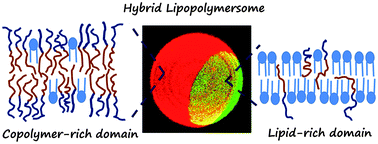
Soft Matter, 2012,8, 7982-7988
https://doi.org/10.1039/C2SM25646K
Interactions of PEO–PPO–PEO block copolymers with lipid membranes: a computational and experimental study linking membrane lysis with polymer structure
Predicted conformation assumed by Pluronics L64 (EO14–PO31–EO14) in DPPC lipid membranes.
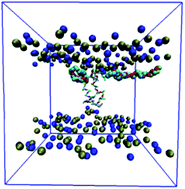
Soft Matter, 2012,8, 6744-6754
https://doi.org/10.1039/C2SM25327E
Hydrophobic droplets in amphiphilic bilayers: a coarse-grained mean-field theory study
Hydrophobic droplets encapsulated in amphiphilic bilayers are studied using a coarse-grained mean-field model for a range of hydrophobic liquids.
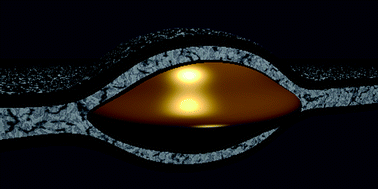
Soft Matter, 2012,8, 3308-3314
https://doi.org/10.1039/C2SM07193B
About this collection
Lipid bilayers act both as a protective barrier and a gateway for biological cells carefully regulating transport of substances to and from the intracellular space. Many proteins, synthetic polymers and nanoparticles have been reported to interact with lipid bilayers, alter their structure and modulate selective permeability of substances through the bilayers. Fundamental understanding and controlling these interactions is critically important to technological advances in various fields such as nanotoxicology, anesthesiology, drug and gene delivery, nanomedicine, biomedical engineering, biosensor development, personal products and cosmetics.
This multidisciplinary topic cannot be addressed within one research field and requires a coordinated effort from scientists with different backgrounds: physicists, physical and organic chemists, biochemists, biophysicists, chemical engineers, medical doctors and industrial researchers. To tackle this problem we have assembled a multidisciplinary team of leading research groups interested in different aspects of interactions of nano-objects with biological and model membranes within Initial Training Network SNAL http://itn-snal.net/. These groups all have synergies in their established research interests and collaborate on joint projects. The team web-site http://softmat.net/ reflects the activities, publications and events of the team. “Workshop on biomaterials and their interactions with biological and model membranes” in Salou, Spain, http://meeting.softmat.net/ attracts researchers closely related to the topic from different countries.
Although the range of subjects in this field is very broad, we would like to stress the importance of collective behavior in interaction of nano-objects with lipid membranes. Classical view of cell biology assumes static structures in the membranes such as pores or channels as a requisite for translocation of substances through the membrane. However, fluid membranes, being nanoscale objects, constantly fluctuate and reorganize. In many interesting cases the interacting substances are not simple molecules but proteins, polymer chains, peptides, which in turn are not static, have conformational entropy and also fluctuate. Thus, there exists a mechanism for translocation of polymers through lipid bilayers via fluctuations induced destabilization of the membranes. This critical adsorption controls the translocation of polymers through the bilayers but also induces enhanced permeability of membranes to solvent and increases the lateral diffusion of lipids and flip-flop rate.
Another aspect of collective behavior in lipid bilayers is the phase separation induced by hydrophobic molecules. Inclusion of oil molecules can lead to formation of oil droplets inside the bilayer, while inclusion of polymers into lipid bilayers can lead to formation of heterogeneous lipid-rich and polymer-rich domains, which can be tuned by temperature. Interacting nanoparticles and polymers can deform highly flexible and elastic lipid bilayers and consequently change their mechanical properties. These and other collective phenomena associated with interaction of nano-objects with lipid bilayers provide new concepts for design of functional biomaterials.
Dr. Vladimir Baulin
Coordinator of Initial Training Network SNAL
http://itn-snal.net/Universitat Rovira i Virgili, Tarragona, Spain